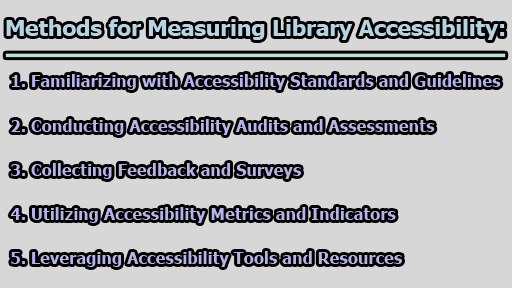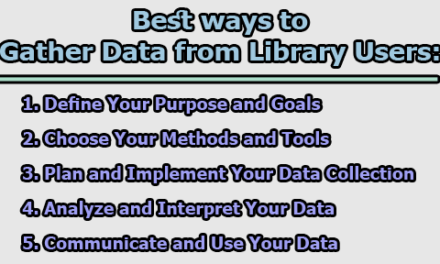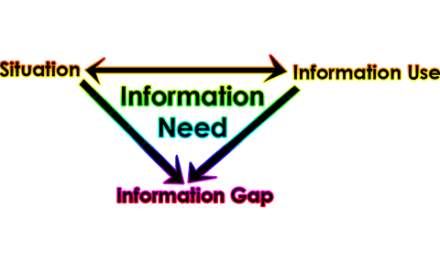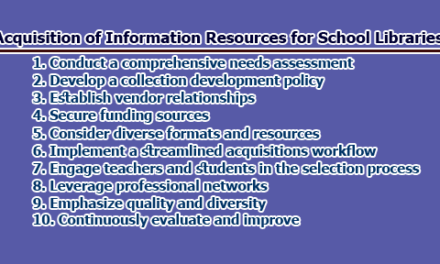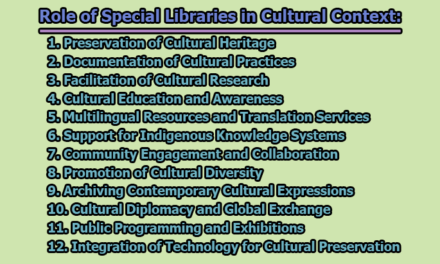Methods for Measuring Library Accessibility:
Ensuring library accessibility for all users is a fundamental commitment for libraries worldwide. To achieve this, it’s essential to employ comprehensive strategies for measuring accessibility and identifying areas for improvement. This article delves into some of the methods for measuring library accessibility, including standards and guidelines, accessibility audits and assessments, feedback and surveys, accessibility metrics and indicators, and the utilization of accessibility tools and resources.
1. Familiarizing with Accessibility Standards and Guidelines: The first step in measuring library accessibility is to become acquainted with relevant accessibility standards and guidelines. These can encompass national, regional, or local laws, as well as professional best practices. For instance, the Americans with Disabilities Act (ADA) sets the minimum requirements for accessibility in public buildings and services in the United States. Meanwhile, the Web Content Accessibility Guidelines (WCAG) offer recommendations for making web content accessible to people with disabilities. By adhering to these standards, libraries can ensure that they meet the fundamental expectations and legal obligations for accessibility.
2. Conducting Accessibility Audits and Assessments: Accessibility audits and assessments represent systematic evaluations of how well a library aligns with accessibility standards and guidelines. These evaluations can be carried out internally by library staff or externally by accessibility experts or consultants. They should cover various aspects of the library, including the physical environment, web presence, collections, programs, and staff training. The insights gained from accessibility audits and assessments can pinpoint the strengths and weaknesses of a library’s accessibility, offering recommendations and action plans for improvement.
3. Collecting Feedback and Surveys: Feedback and surveys from library users and stakeholders are another critical component in assessing accessibility. These responses help libraries understand the experiences, needs, preferences, satisfaction levels, and challenges faced by users regarding accessibility. Gathering feedback can be accomplished through multiple channels, such as online forms, comment boxes, focus groups, interviews, or social media. This method enables libraries to measure the impact and effectiveness of their accessibility efforts while discovering new ideas and suggestions for enhancement.
4. Utilizing Accessibility Metrics and Indicators: Measuring library accessibility can be quantified through metrics and indicators, which serve as tangible measures of accessibility performance. These metrics allow libraries to monitor and track their progress and achievements in enhancing accessibility over time. Data for these metrics can be derived from various sources, such as accessibility audits, user feedback, and library statistics. Examples of accessibility metrics include the number of accessible materials in the collection, the percentage of web pages that comply with WCAG, and the rate of user complaints or compliments related to accessibility.
5. Leveraging Accessibility Tools and Resources: Libraries can streamline their accessibility measurement process by taking advantage of available tools and resources. These resources, which may include checklists, guides, manuals, templates, software, and websites, can assist in the evaluation and improvement of library accessibility. For instance, the Association of Specialized and Cooperative Library Agencies (ASCLA) offers the Accessible Library Services Checklist for assessing accessibility in various areas. The Web Accessibility Evaluation Tool (WAVE) from WebAIM can be used to identify accessibility errors and warnings on library web pages. Employing these tools and resources not only saves time and effort but also allows libraries to learn from best practices and examples in the field.
In conclusion, measuring library accessibility is a multi-faceted process that involves understanding and adhering to accessibility standards, conducting audits and assessments, collecting user feedback, utilizing metrics and indicators, and leveraging available tools and resources. By implementing these strategies, libraries can ensure that their spaces, services, and resources are accessible to all users, regardless of their abilities or disabilities. It’s not just a legal obligation; it’s a moral imperative to create inclusive library environments that cater to the diverse needs of the communities they serve.

Assistant Teacher at Zinzira Pir Mohammad Pilot School and College

